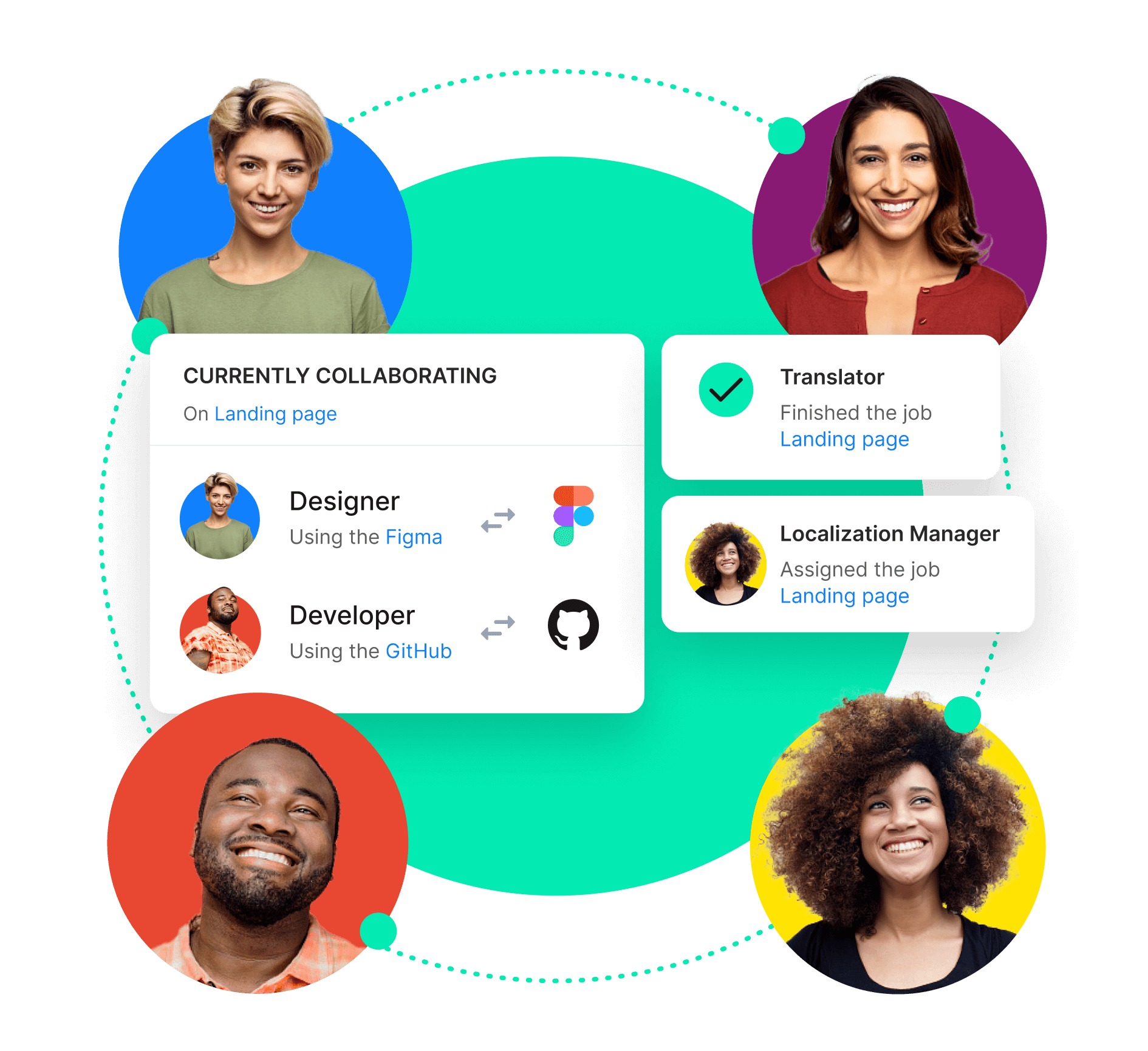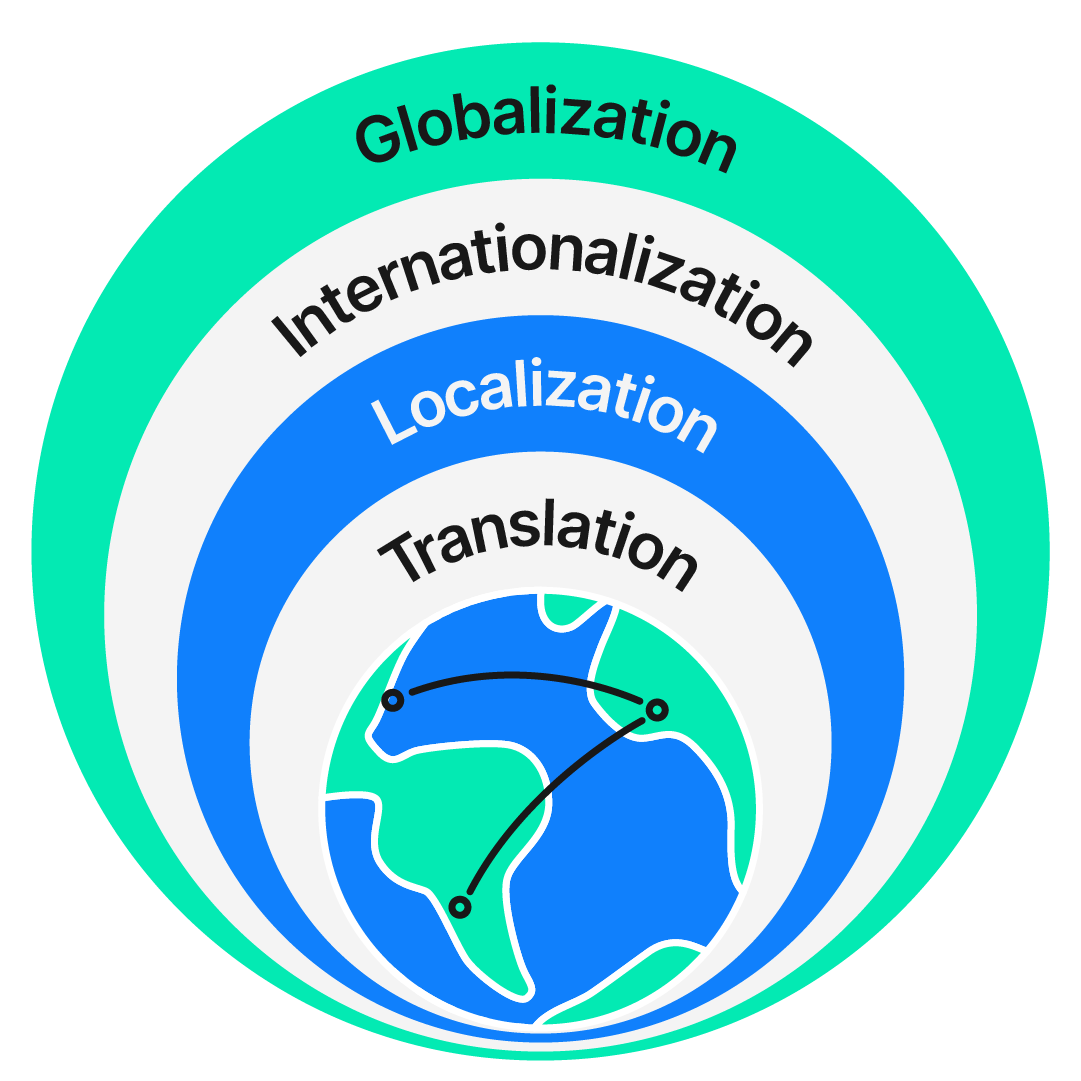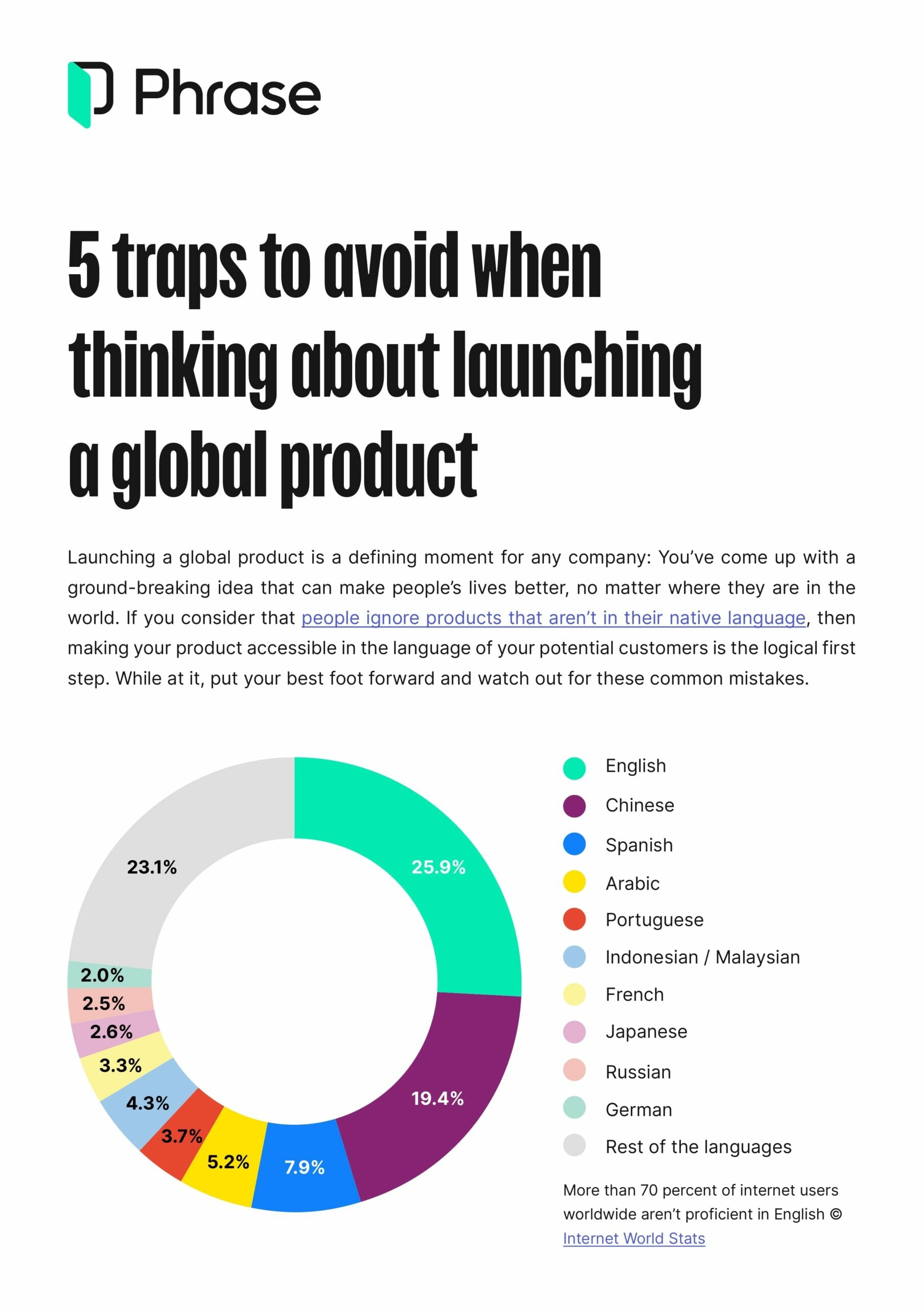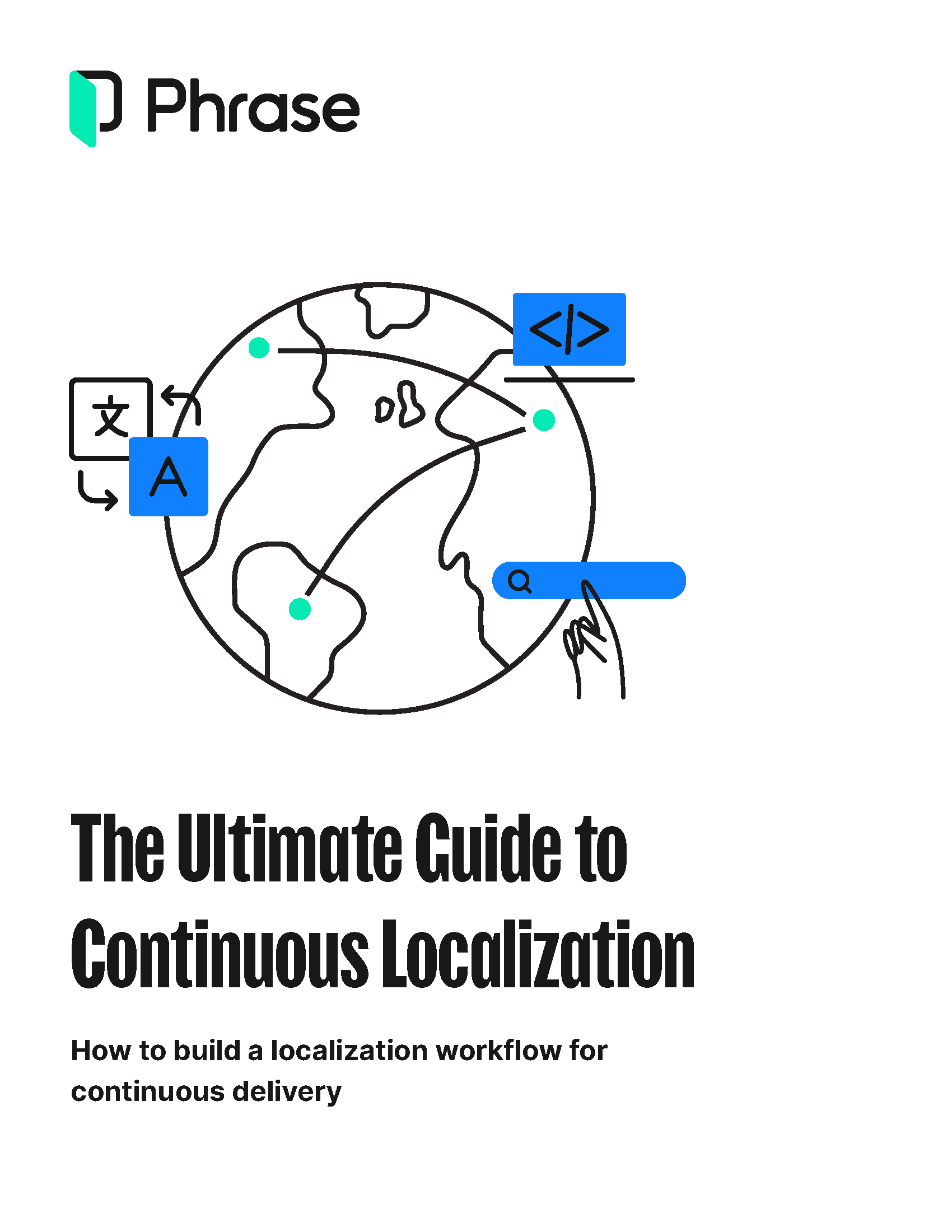Software localization
The Complete Guide to Software Localization

As people across the globe increasingly depend on software in their daily lives, localization has become crucial for providing a seamless user experience (UX) beyond linguistic and cultural boundaries.
The world’s leading tech giants know it well: Regardless of where in the world users are, they can lean on services like Airbnb, Uber, or Spotify in their native languages and enjoy a thoughtfully adapted UX.
This adaptation process is known as software localization and requires a bullet-proof plan that covers everything from strategy and implementation to using the right technology for success.
Follow this thorough guide to understand the ins and outs of software localization, how to plan the process effectively, and how the Phrase Localization Platform can help you get it right the first time.

Unlock global business with the Phrase Localization Platform
Expand into new markets with all the tools you need in one technology suite for high-quality, fast, and scalable localization.
What is software localization?
Software localization is a process in software development that aims to adapt a web or mobile app to the culture and language of users in a target market.
Adapting software to local requirements is a key step in global expansion and can be the difference between a software company that thrives in a fiercely competitive global market and software that struggles to attract an international user base.

To take software global (globalization), your first need to make your product ready for localization (internationalization).
In other words, you first prepare the product—its source code, user interface (UI), and other components—to make adaptation to different cultures and languages easier later on.
Then, you move on with the actual software localization process, which includes translation.
After you’ve adapted your software for a specific locale (a set of language- or country-based preferences for a UI), you can then test and deploy it across various markets.
In a modern agile environment, localization runs in parallel with software development cycles. This means that instead of adding an entirely separate localization workflow to the existing software development process, translators engage with content as soon as developers make it available.

FREE DOWNLOAD
5 traps to avoid when thinking about launching a global product
Most people ignore products in languages that they don’t speak, so give yourself the best chance of success by avoiding these 5 common mistakes in global expansion.
Why is internationalization a prerequisite for software localization?
Internationalization (i18n) in software development aims to design and develop a software product that is ready for global expansion from the very beginning.
Internationalizing software isn’t about adding a language switcher to the UI. Instead, it configures the product to accept diverse forms of data and process it accurately to meet local requirements.
Dive deeper
What is internationalization (i18n)?
Discover why software can effectively adapt to the cultures and languages of global users only through the technical process of internationalization.
Put another way, instead of hardcoding text, internationalization implements placeholders that automatically fetch the right language content for users, eliminating the need for technical adjustments.
The earlier internationalization occurs in the development process, the better. This proactive approach helps developers avoid issues that can be costly to fix later on.
Picture this: A French SaaS company aimed to expand into Canada but hit a roadblock. Their source code, designed only for French users, couldn’t handle Canada’s bilingual demands. As a consequence, they had to do costly and time-consuming code revisions. This experience served as a valuable lesson about the significance of internationalization, highlighting the need to ensure the software is adaptable to diverse linguistic requirements right from the start.
Software internationalization is a technical process and can involve preparing:
- Translatable UI elements: Developers or software localization engineers can move all translatable content into a separate resource file and leave the software code unchanged. This enables translators to perform localization work without touching the source code.
- Text length: While writing software code, internationalization involves developers considering the differences in length between various languages. This way, they can ensure that translated text remains visible in a software interface, even if it’s longer than the original.
- Numbers and currency symbols: Every language has its unique way of formatting numbers and currency, and software must be ready to handle all these variations accurately.
- Date and time: Date and time formats vary across countries, so it’s important for a software product to accommodate these diverse conventions.
- Character encoding: The software should be capable of handling various scripts, including non-Latin ones.
- Language direction: For languages that read from right to left, the software needs to be designed to handle text oriented in any direction.
You can prepare your software for global expansion, regardless of the programming language it’s built on. Phrase supports all major programming languages and frameworks, so feel free to explore our step-by-step software tutorials for guidance on:
- JavaScript localization
- React localization
- Angular localization
- Python localization
- Java localization
- PHP localization
- iOS localization
- Android localization
What’s the difference between software localization and software translation?
Translation is at the heart of the localization process. It’s carried out by professional linguists, preferably native speakers of the target language. However, many tend to equate it with localization, even though there’s a significant difference between translation and localization.
Localization goes beyond mere translation. While translation is focused on transferring words between languages, localization involves adapting images, colors, date and time formats, UI elements, and more to make a software product look and feel as native as possible in a target market.
Software localization is a multilayered process that involves adapting the original content to ensure it resonates with local users and considers cultural nuances, customs, or references that may not be familiar to people outside a certain region. Sometimes, localization requires significant content modifications to make it relevant to the specific market.
Software localization processes vary between businesses, but they generally comprise several core elements:
- UI/UX design: Designers modify the software’s UI to suit your target markets, addressing any design issues (e.g., text exceeding button size). This step also involves introducing UX changes to align with different cultural expectations (e.g., offering locally preferred payment methods), known as UX localization. More on that below.
- Content translation: Simultaneously, the software’s content undergoes translation, and all accompanying assets, such as images or symbols, are adjusted to meet each market’s requirements.
- Testing and quality assurance (QA): Localization testing is essential to ensure that the software’s UI, UX, and functionality are accurate and effective for every region before deploying the software into production.
How to adapt the user experience for an international user base?
Users in different countries have different expectations when it comes to software. Making a software product usable, enjoyable, and accessible for international users implies more than just translating the content. A visually appealing app is often not enough to capture and retain an international user base if the UX is flawed.
UX encompasses the quality of the software’s UI, its usability, and the overall user experience when interacting with your software.
As part of an adaptation process called UX localization, UX designers create a variety of UX elements accounting for variables such as:
- Word length: This might change dramatically from language to language. Some languages expand or shrink horizontally—German is about 35% longer than English while Hebrew is about 30% shorter, for example. Others expand or shrink horizontally—e.g., Asian languages tend to require more vertical space.
- Language direction: In right-to-left languages such as Arabic, UX designers need to reorganize the layout so that UX elements such as action buttons are at the left of the screen and meet the user’s eye when they finish reading.
- Typography: The fonts that designers choose need to cover the software’s supported languages, as some languages (e.g., Arabic or Chinese) include special scripts.
- Symbols, icons, and colors: UX designers need to take into account cultural differences when selecting symbols and colors. For example, while the color green is associated with life and growth in many Western cultures, it symbolizes death in some Asian countries.
- Usability: What may seem natural in one culture may look strange or different in another. Even the ways of getting around an app or website vary from one country to another—empirical studies show differences in task completion rates depending on the use of deep vs broad page navigation structures.
These are just some of the elements that UX designers need to consider when localizing software for international users. It’s all about providing users with a sense of comfort, familiarity, and ease of use, no matter which corner of the globe they may be in.
Software localization testing: Cultural sensitivity audit, legal check, and quality assurance
As soon as translations are available, a separate group of experts—the quality assurance team—tests the software for potential bugs, as well as visual and linguistic inconsistencies. They also audit software for cultural taboos and other potentially sensitive topics, while the legal team adjusts service documentation and other product elements to the specific market legal regulations.
Legal adjustment usually includes such aspects as local privacy law compliance, disclaimer text requirements, tax information, censorship rules, and more. The purpose of the cultural sensitivity check is to avoid topics that formally fall within the legal field but nevertheless might evoke ambiguous or even negative reactions in the target market.
Benefits of software localization
Software localization is crucial for the international expansion and sustainable growth of any digital product in today’s competitive global software market. Even though it might seem costly at first sight, the localization ROI (return on investment) you get can be substantial. Let’s have a closer look at the key benefits of software localization:
A larger user base
While the majority of websites are in English, most internet users speak languages other than English. Here’s a fact: In 2022, 9 of the top 10 markets by app downloads were non-English. When you include those target markets on your expansion agenda, you can significantly enhance your prospects of attracting and converting more users.
Ultimately, how well users can understand and engage with your software product is a significant factor in making purchase decisions. Software that caters to the market’s cultural and linguistic preferences is more likely to win over users, leading to better conversion rates.
Faster time to market
Well-executed software localization can help you launch more quickly into new markets when you have a continuous workflow in place and leverage automated translation from the beginning.
Just like agile development, agile localization involves developers and localization teams collaborating from the start in iterative processes. Continuous localization, a subset of agile, goes a step further by ensuring that content is always ready for release. When developers and translators collaborate seamlessly, software release cycles shorten because localization no longer hampers the process.
This enables you to deploy for various markets simultaneously and localize software at scale in the long run. The faster you move, the greater the chance of seizing market opportunities with minimal delay.
Stronger brand awareness
Building brand awareness is an initial step in gaining new customers, and it can be challenging without localization when you target international audiences. Strong brand awareness can lead to reduced advertising expenses and contribute to enhancing brand value, which in turn makes your product more appealing to potential customers worldwide.
Entering a new market is also a matter of status, which gives you access to symbolic capital. Symbolic capital relates to prestige and recognition. Symbolic capital gives you a chance to become a part of the local cultural landscape, provides access to high-status opinion leaders, and ultimately, helps sell your product more easily.
Enhanced customer loyalty
Brand loyalty is often built on cultural affinity. In other words, customers love it when brands speak to them in their native language. Even non-natives with excellent command of English prefer content in their mother tongue if there’s a choice.
This shows that localized software isn’t just a matter of enabling access to information—it’s also a way of showing respect to local customers. High-quality localization helps retain attention and strengthen loyalty, endorse long-term relationships with customers, and ultimately, trust is what makes sales possible.
Increased revenue
In the end, all of the above factors come together to boost your revenue. On one hand, the larger your customer base, the greater your potential income.
On the other hand, providing a personalized and localized user experience throughout the entire customer journey, from pre-purchase to after-sales support and beyond, results in reduced churn, increased repeat orders, and positive word-of-mouth. All of these aspects impact the bottom line and contribute to growing sales and revenue.

Free download
How to build a localization workflow for continuous delivery
Explore how to implement continuous localization into agile product development to optimize content quality, shorten the release cycle time, and reduce costs.
What is localization software?
Top-quality software localization, especially when a product is envisioned to serve multiple markets, can be a herculean task. Fortunately, companies can rely on localization technology to make their localization workflows faster, easier, and the most cost-efficient.
Localization software enables companies to centralize and automate every single bit of their translation and localization workflows.
In a nutshell, localization software offers features such as:
- A shared, cloud-based workspace for all stakeholders
- Notifications for stakeholders related to software localization status changes
- Support of all popular file formats
- Integrations with the company’s existing systems via software development kits or APIs
- Easy, automated import of software strings from code repositories and export of software strings once localization is complete
- Ability to preview software translations before publishing them live
- Statistics about software localization performance
- Terminology management
- Quality assurance checks
- Ability to include visual references for UI strings that need translating
- Machine translation capabilities
A software localization platform can be the difference between software localization success and failure. Let’s see why.
What are the advantages of localization software?
When the software localization workflow is organized and streamlined through an all-in-one solution, companies can eliminate bottlenecks and significantly speed up software releases in all languages simultaneously, which is reflected in increased revenue and cost savings.
Here are the main advantages of software localization tools:
Decreased time to market
Localization software includes dozens of features that can speed up delivery, such as translation memory, built-in quality control, integration with various platforms—including workflow management tools—and more.
All these functionalities automate most localization tasks so they don’t eat up every team’s time. This allows companies to release software in different languages at once and much faster, which ultimately leads to increased revenue.
The example of Lyst, the largest global fashion search platform, is quite remarkable in this respect. With the help of a software localization platform, Lyst was able to make a giant leap from its startup beginnings in the UK to an international business, operating in 14 markets and launching its content live in 8 languages within just one minute.
Efficient software localization management and team collaboration
Localization means you work with multiple people from different cultural backgrounds and time zones, which makes software localization management a challenging task. It also implies lots of technical aspects and the need for constant communication between linguists, managers, the QA team, and others.
When working with a state-of-the-art localization solution, like translation management systems (TMS) or software localization platforms, you can invite various specialists in your team at any stage, track their progress, and manage their access to the project documentation. Software localization tools make team collaboration more efficient allowing all the members to see the full picture of the translation process.
Continuous workflows
Software development is an ongoing process, and localization needs to run in parallel throughout. That is why it is crucial to implement localization into the development cycle as early as possible—it allows you to release the localized versions along with the main one.
A software localization platform designed to support continuous localization workflows is capable of automatically importing software strings from the main software version, which enables translators to work on these strings while software developers continue to add new content.
Time savings and increased consistency
Localization software allows you to build a comprehensive translation memory—a database consisting of the fragments of the previously translated texts, where each source text fragment corresponds to a target one.
Translation memories are at the core of modern translation technology and let translators reuse translated segments from past projects, which saves their time and your budget
However, the main advantage of translation memories is that they prevent linguistic inconsistencies because translators can ensure that the same source-language term is always translated the same way.
Automated quality checks
The traditional approach to localization used to be based on spreadsheets, where all the translations and reviews were done manually. Leaving ample room for human errors, it led to increased working hours and enormous costs.
A strong software localization platform has a set of quality control instruments that help prevent mistakes and reduce hours. For example, it can automatically check translation fragments for length and syntax, as well as for glossary or placeholder usage.
What is the best localization software?
At first sight, the market is full of various software-as-a-service (SaaS) localization solutions. Nevertheless, not all localization software is created equal—some tools are more focused on translators and their needs, others target developers or UX designers, and others are geared towards project managers.
However, if your goal is excellent multi-language content, opt for the universal all-in-one solution, which is convenient and easily accessible for all team members—product manager, developers, translator, decision-makers, and others.
Also, make sure it is flexible enough to grow with your software localization needs (i.e., that it doesn’t require you to upgrade your subscription plan as you add more software strings); that it has an open API for easy integrations with third-party software; and that it supports as many localization file formats and development frameworks as possible.
| The benefits of localization software in short | |
| Common challenges in software localization | Solutions offered by localization software |
| Translation tasks are repetitive and time-consuming. | Localization software automates most of the repetitive tasks and lets your team focus on timely delivery. |
| There is a lack of consistency—the same terms might be translated differently. | Translation memory capabilities allow you to reuse segments from previous translations. |
| There are lots of simple human errors—like typos or strings mingling with the code—that take hours to review and fix. | Built-in quality control allows you to avoid simple errors. |
| Every new project has to be started from the ground up, extra time is required for briefing and discussing, and there’s a lack of context. | Translation memory and convenient access to all project-related materials allow to speed up the translation process and maintain consistency. |
| Product development cycles are too long. | The time to market decreases from streamlined workflows. |
| Most of the time, each task delivery requires a different tool. | Due to their integration features, software localization platforms let you complete various tasks from the same workspace. |
| Supervising and reporting have to be done manually. | A software localization tool helps to avoid micromanagement and checks project status and statistics immediately, with one click. |
How much does software localization cost?
Cost and return on investment in localization are pretty hot topics when it comes to localization. Every project is at some grade unique. For software localization, the question becomes even more complex because software development projects are usually long-term investments. However, there are key variables that affect software localization costs.
What development costs can I expect during software localization?
As outlined above, the initial step of taking your software global, internationalization, enables your app to support multiple languages and locales.
If you didn’t consider internationalization at the beginning of your development timeline, that is, if your product was not planned to be localized, you might run into extra development time and costs when you decide to add localization into the mix. In this case, your development team would have to go through the entire codebase to spot each string of content to get it replaced by the localized one.
🗒 Tip » Make sure you start internationalizing your software as early as possible.
How are translation costs calculated?
When working with translators and linguists, it is essential to understand the market. Some language pairs are more expensive than others due to their rarity. For example, you might need to dig deeper in your pockets if you need a translation from English to Icelandic, compared to translating from English to Spanish.
The linguistic tasks related to software localization are typically charged either by the word (translation and editing) or by the hour (glossary preparation, translation memory maintenance, linguistic QA, transcreation of highly creative content, etc.).
Some language services providers might agree to discount prices under certain conditions, such as:
- The availability of good-quality translation memory and glossary: When translators and editors can reuse previously translated content, they are able to achieve faster turnaround times and thus lower costs.
- High-volume projects in the current pipeline: Translation service providers are normally happy to offer discounts when they know that they will get more business from you in the near future.
- Availability of localization software to support processes: Translation management systems save time and money by automating repetitive tasks, which results in decreased charges.
- Content suitable for machine translation post-editing (MTPE): Not all content requires human translation—some are easily machine-translatable as long as a human translator edits the output (e.g., internal documentation, customer service emails, highly perishable user-generated content, etc.). MTPE is significantly cheaper than professional human translation, and the best software localization tools include machine translation capabilities that you can leverage.
- Flexible deadlines: Rush jobs, rush prices—just make sure you sort the translatable content by priority to avoid urgency surcharges.
🗒 Tip » Be highly selective by focusing your efforts on your most profitable markets and be willing to find win-win deals with your localization partner.
Project management costs: Why should I invest in a localization manager?
When you embark on your software localization journey, it’s advisable to centralize all efforts under one team or, at least, one person.
Hiring a localization manager to oversee every single bit of the software localization process is a great idea. On top of acting as a bridge between software developers, product managers, the marketing team, translators, business executives, and any other stakeholder involved in software localization, a localization manager will create an efficient workflow by setting up processes, tools, and guidelines that save you time and money in the long-run.
🗒 Tip » Don’t be afraid to invest in software localization management—it will pay off when you get your time back to focus on your customers and revenue growth.
Localization software costs
Some companies still choose not to use a software localization tool for the sake of saving the budget. However, these tools are designed to make the software localization process more efficient and cost-effective by avoiding manual work (which almost regularly delays delivery and increases costs).
They enhance the workflow, allow you to reuse previously translated content, speed up quality checks, ensure consistency across software UI, and integrate seamlessly with your software development platform to speed up localization.
Most tools charge monthly, on a per-user basis, and it’s usually possible to choose between different plans that will include more or fewer features and integrations. Prices are usually per user per month, and custom pricing schemes and discounts might be available if your needs are more specific or your localization volume is high.
However, your best bet isn’t a tool that will charge you more when you pass a certain content volume threshold, simply trying to sweeten the deal by offering you a discount. Because your content is likely to multiply as your business scales, what you need is a true partner that is able to grow with you, adapting to your localization needs, and placing no limits on how much content you translate.
🗒 Tip » Do your research before choosing localization software and make sure it meets these localization tool requirements.
Testing and quality assurance costs
Before your product gets released, the translated text needs to be proofread and checked for potential errors and inconsistencies. The best way to check the quality is to hire another native translator to make sure the initial translation works as intended.
The price of quality assurance varies depending on the volume of content submitted for review, the quality of the original translation, the turnaround time, payment terms, and project requirements.
Just like with translation, if you use a software localization tool that features QA, you can generally expect the process to be faster and the price lower than if the review is done manually.
🗒 Tip » Include quality assurance in your planning early on and aim for at least one iteration.
Marketing costs: Why is marketing localization essential?
To make sure software localization has a positive impact on revenue and overall business success, you need to invest in promoting your localized software in the relevant regions—because no one will be interested in your product unless you know how to sell it right.
This is where marketing localization comes in. By adjusting the promotion of your software in tone and style to more closely resonate with the culture of a target market, you’ll build trust with your audience.
🗒 Tip » Enlist the help of an international marketing consultant to help you make data-driven decisions.
How do you measure software localization ROI?
One of the most difficult tasks in software localization is to accurately measure the return on investment. This is because software localization ROI is not limited to revenue growth—it has multiple dimensions. For example, it will result in a better brand image, higher customer loyalty, and satisfaction as result of a better UX, increased brand awareness, etc.
This makes software localization ROI more difficult to track than traditional marketing activities that are purely about driving sales. What you can do, however, is establish specific, measurable, achievable, relevant, and time-bound software localization goals that are in line with your overall business goals, and track how well you do against them.
Here are some examples of measurable software localization goals:
- Ranking on the first page of Google for x keywords within y months
- Increasing software downloads and sales by x% in each market before the end of the quarter
- Increasing organic website traffic by x% within y months
- Boosting social media engagement by x% over the next y months
Whatever software localization goals you set, make sure they are measurable so that you can track your software localization ROI and adjust strategies accordingly.
In addition to software localization return on investment, remember that you also need to calculate the cost of non-localization, which will help give a more accurate picture of what software localization brings to your company.
In other words, how much potential revenue will your company lose if software localization is not implemented?
Strategic implications: What is your software localization strategy?
Before you can establish the ROI of your localization efforts, you need to ask yourself how it will affect your overall business goals and strategies. Localization needs to be part of a bigger picture and aligned with your company’s strategic objectives.
It’s important that you draw out a plan that involves every department—marketing, product management, business management, software development, etc.—so that software localization is treated as an integral part of your software development process.
So what goes into devising a localization strategy? Here are a few ideas of things you might want to consider:
- Pricing localization: Will you simply convert software prices to the local currency (cosmetic pricing localization) or adjust them based on a specific country’s price index (full pricing localization)?
- Launch timing: How long after the software release will your software be ready for launch in various locales?
- Customer support in the appropriate regions: How will you provide multilingual customer support? Will you invest in hiring support staff locally for each region, or will you provide support remotely?
- Quality assurance: How does software localization affect your current QA process? What software testing frameworks do you need?
- Marketing channel strategy: What is the best channel for advertising your localized software—SEM, social media, print media?
- Localization service providers: What software localization tools do you need to use? How many software translators will you require?
- Local partnerships: Can and will you cooperate with local businesses to provide, for example, local payment options?
The answers to these questions (and any others that might come up) will help inform your software localization strategy and software localization ROI calculations.
Localization testing: How to ensure software quality across languages
Software localization testing is a critical piece of software localization best practices that you cannot afford to overlook. Apart from inspecting for functional bugs, software localization testing should also focus on language quality.
Making sure that your software is translated accurately and completely before launching in foreign markets will help you avoid the major software localization issues associated with software bugs (e.g., negative reviews and poor sales) and reputation damage.
Here are some software localization testing tips to help you get it right. You should check:
- The software interface: Is any text overflowing from the software interface? Is any software text cut off? Do the software buttons, images, and graphics look right?
- The software features: Are all software features functional? Are any software functions missing from the foreign version of the software?
- Branding consistency: Have you maintained software branding and tone of voice across different versions of software?
- Usability: What’s different about the^ software’s functionality in each localized software version? Is it obvious how to use the software in each language?
- Accessibility: Do images include alt text for screen readers? Are software controls keyboard-accessible?
- Language: Do the sentence structures follow grammar rules and software terminology standards for each locale? Is there linguistic consistency within each locale?
For testing purposes, it’s crucial to be able to simulate an environment that is as close as possible to your software’s final destination.
Ready to start building? Pack your software localization kit with these resources
Because we want your software localization efforts to be successful in the long run, we’ve put together a list of guides and manuals for further reading:
Why you should get rid of spreadsheets for localization
Translation management systems are a standard in today’s software localization service industry. Nevertheless, there are still companies that deal with spreadsheets and lots of manual, repetitive tasks. Here’s why everybody should abandon spreadsheets for software localization as soon as possible.
Top 10 mistakes to avoid in software localization
Well-crafted internationalization is the foundation of a successful localization. This ultimate guide for developers walks you through the most common software localization mistakes to avoid.
How to motivate developers for localization
Keeping developers motivated for software localization from the start can be the difference between a business that thrives globally and software that fails to attract an international user base. That’s why it’s key to raise awareness of the why of software localization early on, cultivate a global mindset company-wide, and proactively seek individual partnerships with developers.
How to localize software at scale
Going from a minimum viable product (MVP) to scaling often means taking a look at localization bottlenecks and how to solve them while focusing on your core offering. Learn how to localize software at scale to save time and money as your business grows globally.
Evaluate the best localization software
Navigating the sea of technology vendors in the software localization industry can be quite tiring. To make sure you find the localization software that best suits your business needs, we’ve compiled a few tips on how to create a request for proposal (RFP) for a localization solution.
Speak with an expert
Want to learn how our solutions can help you unlock global opportunity? We’d be happy to show you around the Phrase Localization Platform and answer any questions you may have.






